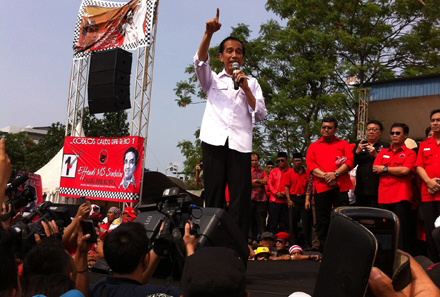Jokowi campaigns for PDI-P. Photo by Tom Power.
The much-anticipated ‘Jokowi effect’ has not given Megawati’s Indonesian Democratic Party of Struggle (PDI-P) the sort of electoral boost many commentators had anticipated. The party went to the polls officially targeting 27.02% of the vote, or 152 national parliamentary seats. Yet at the time of Jokowi’s nomination, serious suggestions circulated that the hugely popular presidential candidate may lift PDI-P’s vote above 30 per cent – a result comparable to the record 33% of the vote won by the party at the first post-Suharto election in 1999.
It appears that PDI-P will fall well short of this target. Although it will win the largest percentage of the vote, it seems the party may only just scrape together enough votes to nominate a presidential candidate without forming a coalition with another party. This would require PDI-P to secure 20 per cent of national parliamentary seats on offer, with the 25 per cent of popular votes otherwise required clearly beyond reach.
Shortly before polling day, a senior member of PDI-P fretted that the party’s advertising strategy had failed to capitalise on the Jokowi factor. Until the last few days prior to the election, PDI-P’s television ads continued to feature Megawati’s daughter and parliamentary faction chief, Puan Maharani, rather than the popular presidential hopeful. As Liam Gammon pointed out on this blog, the party’s advertising strategy had the potential to undermine PDI-P’s legislative result by failing to draw attention to Jokowi’s nomination by the party. Apparently these fears have been realised.
PDI-P parliamentarians in some provinces were hopeful on the eve of the election that PDI-P would win around a quarter of the vote. However, the Indikator count suggests that such results have only been achieved in Central Java and DI Yogyakarta. Many have expressed hopes that the party’s final result would be better than that forecast in the quick count. Others have suggested that it is too early to consider PDI-P’s post-election position.
What is apparent is that this election result may present an unexpected set of challenges to PDI-P, both during the presidential ballot (in the event that they are forced to participate in a nominating coalition), and once the elected candidates take up their seats. Internally, too, this outcome may encourage a more vigorous reassessment of the dynastic nature of PDI-P’s leadership. Disappointed candidates, as well as PDIP activists, may criticise the Puan-led campaign team for its decision to centre the party’s advertising campaign on the Suknarno family rather than its presidential candidate.
While Megawati’s position as general chairperson will remain secure, Puan’s chances of succeeding her mother may recede as the dust settles on 9 April.
The big question is, what will this PDI-P result mean for Jokowi’s Presidential campaign?
While this result should not derail Jokowi’s presidential campaign, it will make the business of government far more complex. One of the major challenges of the Yudhoyono presidency was managing a highly fragmented parliament through a somewhat unreliable rainbow coalition.
It is somewhat unlikely that PDI-P will forge a coalition which includes the more radical Islamic parties, PKS and PPP. However, it is probable that the political configuration resulting from this election will require a PDI-P-led coalition to include Golkar, a party which has not always remained a steadfast coalition partner during SBY’s tenure.
 Facebook
Facebook  Twitter
Twitter  Soundcloud
Soundcloud  Youtube
Youtube  Rss
Rss 